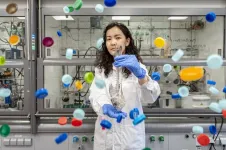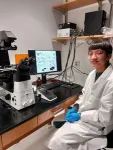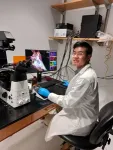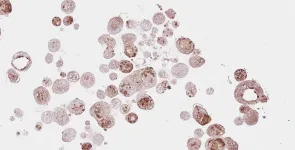The plastic era has begun, and for sure, it will last for decades or even longer. Polymer-based materials are almost everywhere, reaching even the deepest regions of the oceans, and their global production is larger than recycling, leading to the generation of tremendous amounts of water pollution with microplastics. These tiny polymer particles not only release chemicals but also reduce the number of bacteriophages. Recently, researchers from the Institute of Physical Chemistry, Polish Academy of Sciences, led by Prof. Jan Paczesny, explored this field, showing the scale of such a problem. In their work, they studied the effects of microplastics on the infectivity of the bacteriophages in an aqueous environment.
It is challenging to imagine a world without plastic-based products. Synthetic materials are used in every field of life, from textiles, food packaging, and pharmacy, to materials used in the building industry. They are an indispensable part of life because of their multi-functionality. Plastics are lightweight, easily shaped, resistant to environmental conditions, and cheaper than many other synthetic materials, which makes them so popular. However, they are not necessarily friendly to health and the environment, especially when the plastic particles are small. Getting to the water reservoirs, synthetic materials are easily mechanically fragmented into even smaller pieces. They can also undergo degradation under UV radiation, chemical degradation, or even biodegradation, so small plastic particles flow in the aqueous reservoirs for a very long time. Such microplastics with a diameter below 5 mm or smaller pieces like nanoplastic (even a million times smaller than microplastic) are everywhere, even in tap water or the milk of mammals. When these tiny plastic particles get into the environment, they become a serious problem for aquatic systems like lakes, rivers, seas, and even oceans, where they slowly decompose, releasing many harmful chemicals. Unfortunately, the list of them is quite long, starting from plasticizers, pigments, and flame retardants to even heavy metal ions that can cause many disorders or diseases. What is more, the surface of microplastic adsorbs organic compounds that work as food storage for microbial biofilms, leading to an imbalance between the particular groups of microorganisms forming biofilms, including bacteriophages.
Here, the science story begins. Recently, the team of Prof. Jan Paczesny from the Institute of Physical Chemistry, Polish Academy of Sciences, demonstrated the effects of various microplastics on different types of bacteriophages in aqueous media. In their work, scientists used twelve different types of commonly used polymers, e.g., polycarbonate (PC), polyethylene (PE), PET, poly(methyl methacrylate) (PMMA), polypropylene (PP), etc., cut them into tiny pieces, and used them as sources for all prepared materials.
“We judiciously chose industrial-grade polymers to reflect the real sources of microplastic in the environment. We prepared polymer samples by mechanically crumbling larger pieces of commercial-grade plastics. This process simulates how plastic fragments are created in the environment.” - claims prof. Jan Paczesny.
Sounds easy, right? In fact, the experiment is much more complicated to simulate the natural environmental conditions. Besides many features influencing the experiment, the commonly used leachates used as polymer additives play an important role. Researchers found a correlation between the decrease in bacteriophages on the microplastic’s surface and the presence of particular leachates.
Interestingly, the decrease in the number of phages on the surface of microplastic can undergo two different mechanisms. The first one relates to the presence of leachates that can deactivate even 50% of phages. The second one correlates with certain sizes of polymer materials, where the generation of nano- and sub-microparticles plays a key role and the adsorption results in phage scavenging.
Prof. Paczesny remarks - “The effect of leachables was measured upon exposure of phages not to particles themselves but to the buffer preincubated with microplastics. A double-overlay plaque counting method was used to assess phage titers. We employed a classical linear regression model to verify which physicochemical parameters (65 variables were tested) govern the decrease of phage titers.”
The research study focuses on the correlation between the number of phages and the physicochemical properties of microplastics as an introduction to the broad field of ecotoxicological studies. As only daily, the bacteriophages terminate up to 40% of bacterial biomass, they play a vital role in the maintenance of homeostasis in the bacterial community in all environments, from Big Blue to wastewaters. Once the microplastic gets into the environment, its surface hosts the biofilm layer, which is a booster for microorganisms to colonize, and here is the problem. Transported through the microplastics, many bacterial strains can colonize uncontrollably. As an effect, they can affect ecosystems in certain aquatic zones without the control of the phages, affecting not only animals but also humans. What does it mean in practice? Let’s take a look at the seafood. Microplastic reaches the digestive tract of fish and other animals, disturbing the gut biota as well as forming aggregates in other tissues. Therefore, when we consume them, such microplastic gets into our digestive system, and with a decrease in the size of these polymer pieces, it can also aggregate in the body, which can lead to severe health issues. It sounds scary, but from the findings of scientists from IPC PAS, it is clearly seen that the growing pollution of the environment with microplastics can have a dramatic effect on global ecosystems.
Based on these findings, the main take-home message is: proper recycling and the deep need for the reduction of plastic in life!
The work on the microplastic effect on phages was published in the Journal of Environmental Quality. The research was financed by the National Science Centre, Poland, within PRELUDIUM BIS grant 2020/39/O/ST5/01017 and SONATA BIS grant 2017/26/E/ST4/00041.
END






